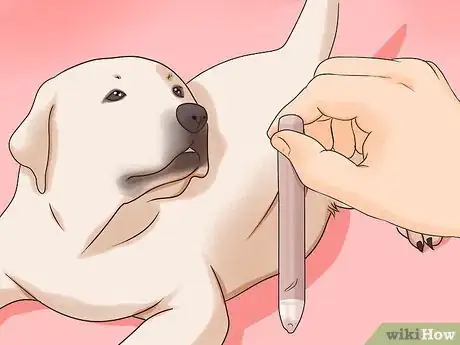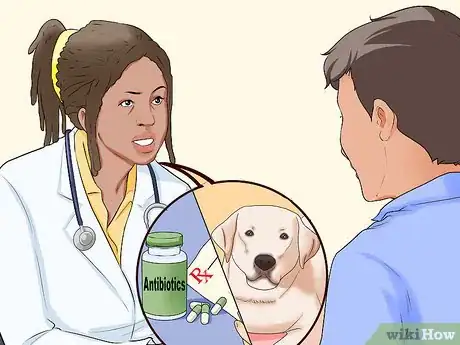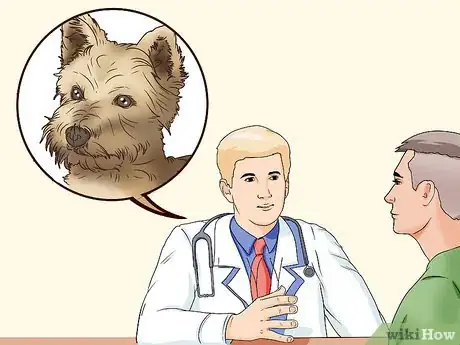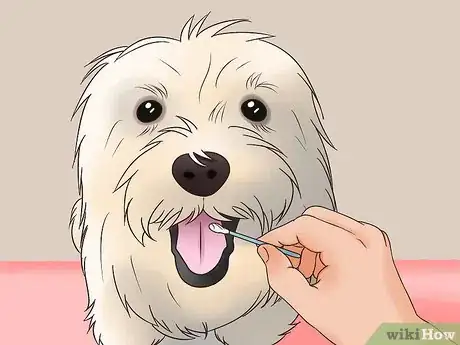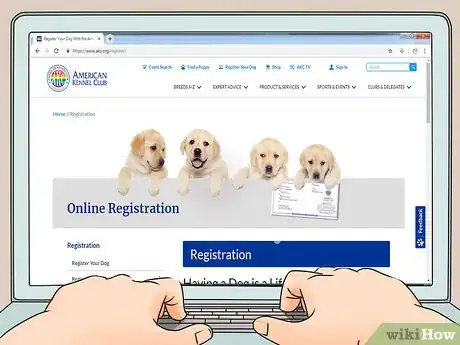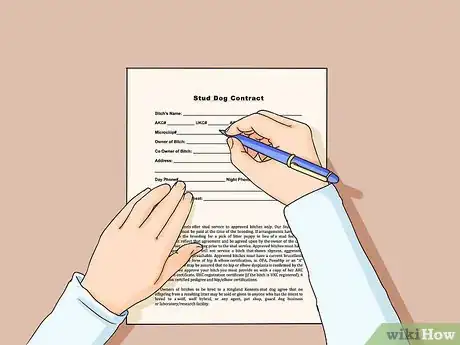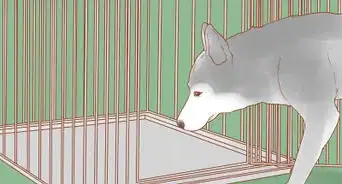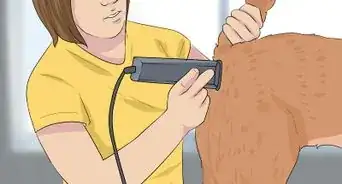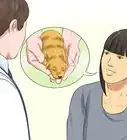This article was co-authored by Tom Robertson. Tom Robertson is a Dog Breeding Specialist and the Owner of Prize Poodles and Doodles. With over 20 years of experience, he specializes in breeding doodles. Tom has also received additional educational training in dog grooming, boarding, and training.
This article has been viewed 136,600 times.
As a dog owner, you may decide to breed your male dog for profit and to promote his breed with other dog owners. You can find a reputable breeder to help you mate your dog with a female or try mating the dog on your own. To determine if your male dog is ready for breeding, you should confirm his health, his genetic traits, and his fertility. You can then establish your male dog as a stud and breed your dog with a female dog to create a litter of healthy puppies.
Steps
Confirming Your Male Dog’s Fertility
-
1Make sure your dog is of breeding age. Male dogs should only be bred once they are at least 1 ½ to 2 years of age. Many health tests cannot be run on dogs until they are two years of age, so you should only breed your male dog when he is of age and cleared for breeding.
- Depending on your dog’s breed, he may not be able to mate successfully after the age of seven years old. You may need to speak to your vet to confirm your dog is healthy enough to breed if he is over seven years old.
-
2Get a fertility check done. Some male dogs may experience infertility or difficulties with breeding because they are too young or too old for breeding, they have a low sperm count, or they have a disease or disorder. You should confirm your dog is fertile and able to mate with a female dog before you proceed with the breeding process. Your vet can do a physical exam of your dog’s genital area and run tests to confirm your dog is fertile.[1] [2]
- Your vet will exam your dog’s reproductive anatomy and his prostate. They will also collect semen from your dog to be examined. If your dog is older, the vet may also require a sperm sample for testing.[3]
- The vet will do a semen count to make sure your dog has a good amount.[4]
- Your vet may also ask you about your dog’s history of breeding. For example, they may ask, “Has your dog mated successfully with a female before?” “How many litters has your dog sired?” “What issues does your dog seem to have during mating?”
Advertisement -
3Confirm your dog’s fertility with your vet. Once your vet has run tests and examined your dog, they should tell you if your dog is fertile or infertile. If your dog is having fertility problems and he is young in age, your vet may tell you to wait one year and then have him retested to see if his fertility improves with age.[5]
- If your dog has a thyroid issue that results in a low spear count, your vet may recommend thyroid replacement or a hormone replacement.
- If your dog has prostate issues, such as an infection, your vet may recommend antibiotics and hormone therapy.
Getting Health and Genetic Checks on Your Dog
-
1Have your dog examined for health issues. Before you breed your male dog, you should confirm he is in good health. Ask your vet to do a complete physical exam on your dog to check for health issues like hip dysplasia and joint problems. You want to be sure your dog does not have these health issues as you do not want them passed on to his litter when he does breed with a female dog.[6]
- Your vet should also check his ears and his eyes to ensure they are in good working condition.
- You should have your vet run a blood test and a urinalysis to check for any diseases or disorders, such as bone disease.
-
2Determine your dog’s genetic traits. You should also have tests done to confirm your dog’s genetic make up, especially if your dog is not a pure breed. Having clear information on your dog’s genetics can help you match him with a mating partner and get a good idea of the genetic makeup of any puppies he sires. You can arrange for a genetic test through your vet or through a trusted online testing service. You will need to provide a swab sample from your dog to complete the genetic test.
- The cost of a genetic test can range from $60 to $150. These tests will tell you about the dog's heritage and therefore any diseases they are at greater risk of carrying. They do not, however, tell you if a dog carries the gene for those diseases or not.
-
3Confirm your dog's breed standards. Study the standard for your dog’s breed and confirm he is a healthy example of his breed. Research your dog’s breed on through the breed’s national parent club to find out more about what traits your dog should possess in order to breed. Some traits may be physical, such as a certain color to his coat or a certain shape to his body. Some traits may be behavioral, such as a certain demeanor or personality to your dog.[7]
- You can also speak to other pet owners who have the same breed to get a sense of the standards for the breed. You want to ensure your male dog is a high example of his breed, as this will increase the quality of any litters he sires.
Establishing Your Male Dog as a Stud
-
1Determine your dog’s ideal female mate. You may want to establish your male dog as a stud that is suitable for breeding so you can find female mates for him more easily. Part of doing this is ensuring you know the ideal female mate for your dog. Make sure the dam complements your dog. Go for a dam who has a strong bloodline and qualities that will suit your dog’s qualities, such as physical appearance or level of intelligence.[8]
- You should also look for a female dog that has a temperament that is calm, collected, and friendly, as this often indicates she will be a good mating partner.
- Make sure the female dog is in good health and does not have any genetic issues. This will ensure the resulting litter is free of health problems or deficiencies.
-
2Register your dog with the American Kennel Club. Though not required, registering your dog with the American Kennel Club (AKC) will let other owners know that your dog is recognized as a suitable option for breeding. You will need to have certified ownership of your dog to register him with the AKC.[9]
- You can find out more on registering your dog with the American Kennel Club by looking at their website or by contacting them by phone.
-
3Create a stud contract. Once you have decided to make your dog available for breeding, you should draw up a stud contract. A stud contract should cover where the breeding will occur, as well as outline the stud fees, which will be set by you, the male dog’s owner. You may request a cash fee, a “pick of the litter,” or one or two puppies from the resulting litter. The contract should be signed by you and by the owner of the female dog before the breeding takes place.[10]
- If you are unsure how much to charge in the stud contract, talk to your dog’s breeder or the American Kennel Club for guidance.
- If your dog has not been used as a stud before, you may charge the female dog owner a nominal fee to cover health checks and fertility checks as part of the contract.
References
- ↑ http://www.petmd.com/dog/conditions/reproductive/c_dg_infertility_in_male_dogs
- ↑ Tom Robertson. Dog Breeding Specialist. Expert Interview. 5 April 2022.
- ↑ Tom Robertson. Dog Breeding Specialist. Expert Interview. 5 April 2022.
- ↑ Tom Robertson. Dog Breeding Specialist. Expert Interview. 5 April 2022.
- ↑ http://www.petmd.com/dog/conditions/reproductive/c_dg_infertility_in_male_dogs
- ↑ http://www.petmd.com/dog/conditions/musculoskeletal/c_dg_hip_dysplasia
- ↑ http://www.akc.org/dog-breeders/responsible-breeding/#
- ↑ http://www.akc.org/dog-breeders/responsible-breeding/#
- ↑ https://www.thekennelclub.org.uk/media/8261/breeding.pdf
About This Article
To know if your male dog is ready to breed, wait until it’s around 2 years old, which is the age when fertility tests can be safely performed on male dogs. Then, take your dog to the vet, who will examine its genital area and test its semen. If there are any issues, the vet may suggest re-testing after a year, since fertility can improve with age. Alternatively, if your dog’s fertility is confirmed, you may want to consider additional testing to learn about any general health or genetic issues before breeding your dog. For more information from our Veterinary co-author, including how to establish your dog as a stud, scroll down!

